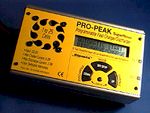

| Get Started In Electric Flying |
Electric flying is something I've just got into myself! I have been flying over 21 years but wanted to try this side of the hobby. I do not profess to know the ins and out and all the technical details of watts, amps, milliamps, brushless motors or the number of turns required to make a hot motor. But outlined below are some of the basic things I have learnt while getting into the electric side of our hobby. I hope it will help you understand some of the basic concepts.
Indoors Or Out?
Deciding what to buy all depends on what you want to fly. Outdoors or
indoors? Indoor models, although smaller and less expensive tend to be
a little more difficult to fly if you are a novice. This is because of
the confined spaces in which most indoor models are flown. The walls always
seem to close in on you after you take off! Most people probably start
with an outdoor model. One of the most popular models currently is the
Multiplex Twinstar, or if you want something that's a bit more responsive
the Multiplex Twin Jet is also very popular. Although I have started with
the Kavan Partenavia (see review
on this site).
All these models are made of expanded polystyrene foam. This gives them a very light structure and cuts down on building time. The standard electric motor is the Speed 400 or Speed 480. These are usually used without gearboxes (direct drive) in the above examples. They use plastic 'Gunther' props (usually supplied) which just push on to the motor shaft or a props around the 6x4 size, which will require a small prop adapter.
 Speed
Controllers
Speed
Controllers
Models of this size can use standard radio gear but sometimes people will
use smaller servos to save weight. A speed controller is in fact your
throttle control. These are sometimes called ESC's - Electronic Speed
Controllers, The ESC is small electrical devices that, at one side plug
into your power pack battery and out of the other side to your motor(s).
They also contain a servo lead that plugs into the socket on the receiver
usually used for the throttle. This eliminates the need for a throttle
servo, as the speed of the motors is controlled through the ESC. Some
ESC's also have a seperate 'arming' switch.
Most ESC's have what is called a Battery Eliminating Circuit (BEC) this means that all your on board radio gear (rx, servos) are powered from just the one motor power pack, thus eliminating the need for a separate battery to power your radio gear. When the power pack discharges to a fixed voltage during flight, the BEC will automatically cut the power to the motor(s) at that point, but continue to supply the receiver. This allows you to land safely with out loss of radio communications.
ESC's are rated at different ampreages, from around 2 amps to 50 amps. You choose the one to suit your power pack and motors. In the above examples the Twin Star usually uses a 7 or 8 cell pack (8.4v - 9.6v), which will draw around 20 to 30 amps. In this case an ESC rated at 35 amps would suffice.
 Battery
Power Packs & Charging
Battery
Power Packs & Charging
Battery packs come in a variety of sizes and number of cells. Each cell
has a voltage of 1.2v. But cells are also rated by the amount of charge
they can hold. This again is rated in amps or milliamp hours. So if you
see a pack marked 8 cell 2000mAh, then it will have a voltage of 9.6v
(1.2 x 8) and will be able to hold a current of 2 amps (2000mAH). A constant
current of 2000 milliamps would take 1 hour to discharge the pack. Of
course our models draw a lot larger current than this during a flight
and the pack discharges more quickly. In around 6 to 8 minutes usually.
Conversely, a 2000 mAh pack can be charged in 1 hour if supplied with
2 amps! There are many fast chargers on the market. All have their pros
and cons. I use the Super Nova 250s. At around £70 it has features
that more expensive charger don't have. It will charge and discharge your
power packs automatically, both NiCad and Nickel Metal Hydride (NimH).
But you can also set in your own rates manually as well if you wish. (See
the diagram in our 'How To' section). It can
also charge your 12v field battery (Pb - plasma battery). One disadvantage
of the Super Nova is that it runs from a 12v supply. Great at the flying
field where you just plug onto your car battery, but not so good at home
if you want plug into the mains! However, transformers are available. (You will need between 9 and 15 v constant
supply at 5 amps for the Super Nova. Maplins produce such a transformer
for around £45). In my experience the Super Nova will charge a 2000mAh
pack in around half an hour.
transformers are available. (You will need between 9 and 15 v constant
supply at 5 amps for the Super Nova. Maplins produce such a transformer
for around £45). In my experience the Super Nova will charge a 2000mAh
pack in around half an hour.
One final point about batteries. A new pack must always be given a slow charge for the packs first charge. This conditions the pack for fast charging by giving the pack its full capacity. If you were to give it a fast charge to start, the pack may never again reach its full capacity, thus giving you less running time. A slow charge is usually at a 1/10th (or C/10) of the pack's capacity. 200mAh for 10 hours in our example. Although in reality this is usually about 12 -14 hours.